Technology
Onboarding the AI workforce: How digital agents will redefine work itself

Join our daily and weekly newsletters for the latest updates and exclusive content on industry-leading AI coverage. Learn More
AI is rapidly evolving, poised to transform the workplace in ways that were thought of as science fiction only a few years ago. For example, Google recently updated its NotebookLM, an AI-powered research assistant and note-taking tool, with Audio Overview to turn documents into audio discussions. Writing in ArsTechnica, Kyle Orland describes how he used this feature to create a “disarmingly compelling” 12.5-minute podcast-style conversation about a book he had written. The conversation was “between two people who don’t exist.”
This highlights a broader trend of AI evolving to replicate human-like behaviors — a development that will soon reshape how businesses work, and how workers engage with technology.
NotebookLM uses Google’s Gemini gen AI large language model (LLM) and pairs it with its recent AI-generated voice capability. Discussing how well this works, Graham Barlow writes in TechRadar: “[The bots] talk with passion and authority about the subject, sound engaged and interested and riff off one another in such a natural way that it takes your breath away. There are even the little sniffs, slight mispronunciations, slurs and little giggles that all make it sound completely human.”
This is just one of the many ways that the AI revolution is taking shape.

Challenges with AI remain, including hallucinations and inherent biases in training data. As these issues lessen or ideally are resolved, the role of AI will expand from automating simple tasks to reshaping how work is done, how businesses run and how employees interact with technology.
From AI-driven decision-making to immersive customer experiences increasingly powered by digital humans (synthetic creations that emulate humans in their on-device appearance, mannerisms and voice), the future of work will be more efficient, more creative and perhaps more human-centered than we can currently imagine. Here are some of the changes that are coming.
AI in 2030: A transformative force
1. AI agents are integral team members
By 2030, AI agents will be fully integrated into enterprise operations, serving as collaborative team members rather than simple task handlers. An AI agent is a software entity that autonomously completes tasks and, increasingly, coordinates with other agents to achieve complex goals, often using machine learning or rule-based systems.
Today’s AI systems help improve processes, but their future lies in taking over more complex roles. In sectors such as customer service, logistics and project management, AI agents will manage routine tasks, while providing human workers with real-time insights and analysis. With its ability to handle complex tasks, the new “o1” model from OpenAI will further advance this capability.
2. The emergence of digital humans
Digital humans (lifelike, AI-powered avatars that can interact in real time) have begun to make their mark in customer service and sales, and their impact will be profound by 2030. Equipped with highly realistic facial expressions, natural language processing (NLP) and human-like speech, these avatars will function as front-line customer service agents, onboarding specialists, inside sales representatives or even virtual brand ambassadors.
For instance, when customers interact with a brand’s website or call center in 2030, they might be greeted by a digital human capable of understanding their needs, recalling past interactions and resolving issues with an intuitive, conversational approach. This could be a major improvement over the numbing or even infuriating customer support most of us routinely experience today.
Unlike current AI chatbots, these systems will feel less transactional and more like human-to-human communication. That said, as AI systems become indistinguishable from human interaction, companies will need to clearly show when AI is involved to support transparency and trust in customer relationships. My guess is that most people will be happy to interact with an AI if it means getting their issue resolved with less friction.
3. AI-driven speech and conversational interfaces
By 2030, fully human-sounding, interactive speech will be ubiquitous in customer service, internal meetings and even creative brainstorming sessions. AI-powered voices will be indistinguishable from human ones, capable of holding fluid, natural conversations. As reported last week in VentureBeat, the newly available ChatGPT Advanced Voice Mode with nine different voices is an early instance of this capability.
With this advancement and others including from startup Hume, AI systems will begin to seamlessly integrate into daily operations, guiding customers through processes, answering complex questions and even participating in meetings as conversational partners. A recent headline in Tom’s Guide sums up this capability: “I just had a conversation with Hume’s new AI voice assistant — and I forgot it wasn’t human.”
4. AI-enhanced decision-making and leadership
As AI-powered digital humans enhance customer interactions by emulating human behavior, the broader impact of AI will be seen in how it reshapes decision-making across organizations, offering leaders real-time insights and strategic support. AI will not just streamline tasks — it will provide executives with real-time dashboards, predictive analytics and scenario-planning capabilities that help leaders make data-driven decisions faster and more effectively. In this context, AI becomes not only a tool but an advisor—able to offer insights that guide strategy.
For example, AI-powered digital assistants could sit in on leadership meetings, offering real-time suggestions or running simulations based on ongoing discussions. Some companies have already appointed AI bots as observers to their boards and are putting tech at the center of their board strategy work.
5. Innovation and research powered by AI
Within the next couple of years, AI-driven simulations and predictive modeling will be critical to testing new products, business models and market strategies. This is already being done in the form of digital twins, but increasingly enterprises will rely on AI to gather insights, predict trends and refine prototypes before they enter production.
AI will also enhance creativity and collaboration. In brainstorming sessions, for instance, AI systems will suggest ideas drawn from massive datasets and global trends, helping human teams unlock new insights. Combined with digital humans or AI-driven conversational interfaces, teams will be able to engage in dynamic, cross-disciplinary discussions that push the boundaries of innovation.

6. The changing nature of job roles and skills
As AI takes over routine and data-heavy tasks, the nature of job roles will shift toward oversight, creativity and human-centered skills. AI trainers, ethics officers and AI maintenance professionals will be critical in ensuring that AI systems run effectively and ethically. These are some of the new jobs that will be created as AI becomes more ubiquitous at work. Continuous reskilling will become the norm, as workers adapt to rapid advancements in AI technology.
Human abilities such as creativity, critical thinking and emotional intelligence will remain irreplaceable. AI may manage the analysis and data, but humans will need to drive strategic vision, ethical considerations and empathetic customer interactions.
To fully realize AI’s potential while mitigating its risks, businesses must invest not only in the technology itself but in robust AI governance frameworks and continuous reskilling programs to ensure both ethical use and a workforce that can effectively collaborate with AI systems.
Preparing for the AI-driven future
Just as Google’s NotebookLM and OpenAI’s Advanced Voice Mode shows AI’s increasing ability to emulate human behaviors, the coming years will see enterprises harnessing these technologies in ways that reshape industries. In the view of venture firm Sequoia Capital: “Every industry that requires humans to create original work — from social media to gaming, advertising to architecture, coding to graphic design, product design to law, marketing to sales — is up for reinvention.”
Companies at the vanguard of AI adoption are now widely implementing the technology. For example, HBR reported that Moderna’s deployment of ChatGPT has led to more than 750 custom GPTs developed across business functions, with each user averaging 120 ChatGPT enterprise conversations per week. Companies that delay using AI risk falling behind in both innovation and competitiveness.
By 2030, AI will have evolved from a back-office assistant to a front-line collaborator in most companies and in nearly every aspect of enterprise operations. Workers who embrace AI as a partner, rather than a competitor, will thrive in this new environment.
A major ongoing concern is the potential for replacing human employees with AI. One group of employees thought to be particularly at risk is entry-level white-collar workers. However, a new poll of more than 2,100 interns at investment banker Goldman Sachs points in the opposite direction. As reported by Quartz, nearly all — 93% —of the investment bank’s latest interns believe AI will enhance their work, not replace it.
A common but applicable refrain now is “AI won’t replace employees, however, employees who use AI will replace those who don’t use AI.” As proof, Microsoft and LinkedIn’s 2024 Work Trend Index found that 71% of business leaders would rather hire a less experienced candidate with AI skills than a more experienced candidate without them.
For businesses, this means actively investing in reskilling initiatives and establishing strong AI governance to ensure that AI not only boosts productivity but also aligns with ethical standards and enhances customer trust. Strong AI governance will require clear accountability for AI-driven decisions, safeguards against bias and strict adherence to data privacy standards to support trust and transparency. IBM offers a good example. The company has set up comprehensive frameworks that emphasize accountability, bias mitigation and data privacy, fostering trust and transparency in its AI-driven outputs.
On the precipice of change
As we stand on the cusp of this AI-driven future, the workplace of 2030 will be radically different from today’s. From AI agents and digital humans revolutionizing customer interactions to AI-enhanced decision-making reshaping leadership, the potential for transformation is immense.
Yet, the true power of this revolution lies not in AI replacing humans, but in the symbiosis between human creativity and AI. The organizations and individuals who thrive in this new landscape will be those who embrace AI as a partner, continuously adapt their skills and leverage technology to amplify their human potential.
Gary Grossman is EVP of the technology practice at Edelman.
DataDecisionMakers
Welcome to the VentureBeat community!
DataDecisionMakers is where experts, including the technical people doing data work, can share data-related insights and innovation.
If you want to read about cutting-edge ideas and up-to-date information, best practices, and the future of data and data tech, join us at DataDecisionMakers.
You might even consider contributing an article of your own!
Source link
Technology
Origami computer uses folded paper for calculations


An origami logic gate could form the basis of a computer
Michael Assis
Paper folded according to the rules of origami can theoretically perform any computation imaginable, from adding numbers to running the latest artificial intelligence software, though in practice this is unlikely to be useful.
While we normally think of computation as something done using silicon chips, anything capable of representing and manipulating information can be used as a computer – for example, dominoes arranged in the correct pattern are able to add together two numbers.
Servers computers
Dell PowerEdge R760 and R660 Servers

The new Dell PowerEdge R760 and R660 Servers provide performance and versatility as needed to address your most demanding applications and workloads.
Learn more – https://www.dell.com/PowerEdge .
source
Technology
Hulu Plus Live TV: plans, price, channels, DVR, and more
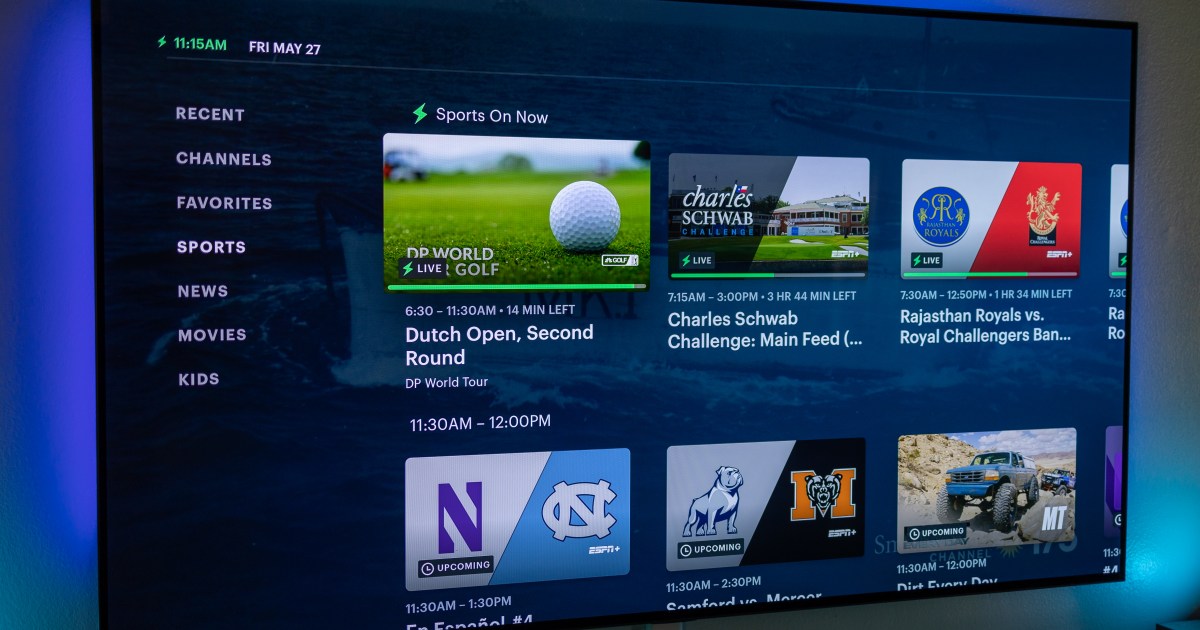
If you want to cut the cable but you aren’t ready to let go entirely, one of the best live TV streaming services out there is Hulu Plus Live TV. Billed as a Multichannel Video Programming Distributor (MVPD), Hulu Plus Live TV (also referred to as Hulu With Live TV) provides many of the features you’ve come to expect from your cable package. Along with live TV, you get access to Hulu’s streaming library which includes thousands of hours of video including existing favorites, alongside original programming like The Bear and The Handmaiden’s Tale. Since Hulu is owned by Disney, you can even bundle Hulu Plus Live TV with Disney Plus and ESPN+ for even more content.
There’s plenty to learn about Hulu Plus Live TV, and we’ve compiled all the most salient information into this helpful explainer. And do be sure to check back often, as Hulu With Live TV pricing and capabilities have been known to change in the blink of an eye.
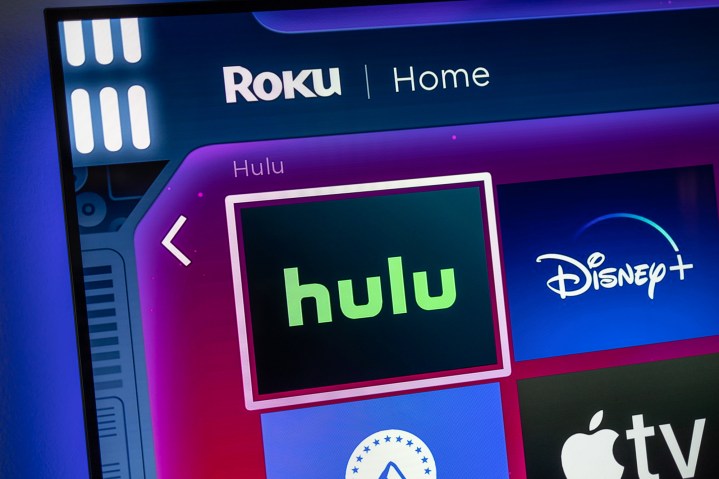
Hulu Plus Live TV prices and plans
As of this writing, Hulu Plus Live TV’s 90-plus channel base plan costs $77 a month, and includes Hulu (with ads) + Live TV, and actually comes with a couple of pretty huge incentives — ESPN+ (with ads) and Disney+ (with ads). However, be mindful that Hulu is raising prices in October 2024.
Your Hulu Plus Live TV subscription also comes with unlimited recording. That matches what’s available on YouTube TV with 100 channels and which costs $73 per month.
There are channel add-ons available, too, so you’re able to watch more from within the Hulu app itself. They include:
- Max (with ads) at $10 per month
- Max (no ads) at $17 per month
- Paramount+ with Showtime at $13 a month
- Cinemax at $10 a month
- Starz at $10 a month
There’s also a trio of “network add-ons” that add even more channels to your Hulu With Live TV experience. Here’s how they break down:
- Unlimited Screens ($10 a month): You are able to watch two screens at the same time on the base plan, but this upgrade allows you to watch on as many devices as you want on your home network and up to three at once while you’re on the road (with the exception of five devices at once at home for the four add-ons below).
- Sports Add-on ($10 a month): You’ll get NFL RedZone, MAV TV, Outdoor Channel, Sportsman Channel, FanDuel Racing, FanDuel TV, Strike Zone, and the Tennis Channel.
- Entertainment Add-on ($8 a month): American Heroes Channel, BET Her, Boomerang Channel, CNBC World, Cooking Chanel, Crime + Investigation, Destination America, Discovery Family, Discovery Life, Hallmark Drama, Nicktoons, Great American Country, Military History, Science, TennNick, MTV Classic, and MTV2.
- Español Add-on ($5 a month): CNN Español, Discovery en Español, Discovery Familia, ESPN Deportes, Fox Deportes, Hogar de HGTV, NBC Universo, The Weather Channel en Español, and History en Español.
Hulu Plus Live TV and the Disney Bundle
Currently, when you subscribe to Hulu Plus Live TV, you also get ESPN+ (with ads) and Disney+ (with ads) included with that $77-a-month fee. But there are a couple of additions you can make to this base bundle. Of course, this jacks the price up for each package. Here’s what that looks like:
- Hulu (no ads) + Live TV, ESPN+ (with ads), and Disney+ (no ads): $90 per month
- Hulu (with ads) + Live TV, Disney+ (no ads), and ESPN+ (with ads): $82 per month
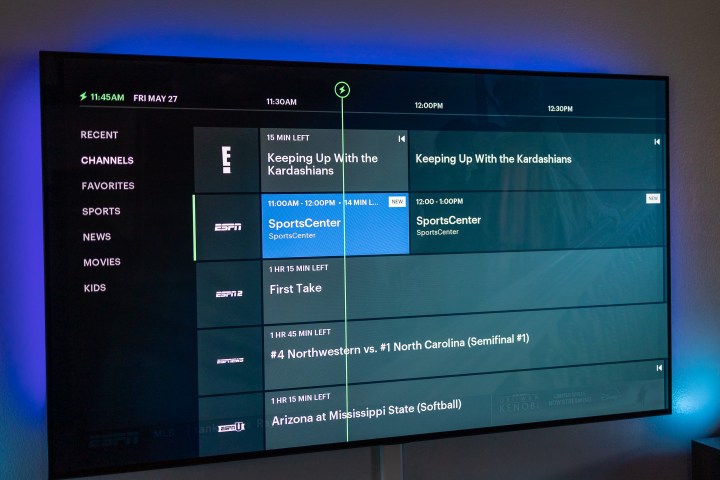
Hulu Plus Live TV channels
Hulu With Live TV has over 90 channels as of the autumn of 2024. That’s a decent amount, though not the biggest number you’ll find in the streaming world.
The following are the channels that are currently available on Hulu With Live TV. Note that it’s possible that some channels may be unavailable where you live — that’s a pretty standard caveat amongst all the providers. And while we’ll do our best to keep this list up to date, channels do come and go as contacts expire.
A&E, ABC, ABC News Live, ACC Network, Adult Swim, Animal Planet, BET, Big Ten Network, Bloomberg Television, Boomerang, Bravo, Cartoon Network, CBS, CBS News, CBS Sports Network, Cheddar News, CMT, CNBC, CNN, CNN International, Comedy Central, COZI, Crime & Investigation, CW, DABL, Discovery, Disney Channel, Disney Junior, Disney XD, E, ESPN, ESPN College Extra, ESPN2, ESPNews, ESPNU, Food Network, Fox, Fox Business, Fox News, Freeform, FS1, FS2, FX, FXM, FXX, FYI, Golf Channel, HGTV, History, HLN, Investigation Discovery, Lifetime, Lifetime Movies, Localish, Military History, MotorTrend, MSNBC, MTV, NASA, Nat Geo Wild, National Geographic, NBC, NBC News Now, NBCLX, News Nation, NFL Network, Nick Jr., Nickelodeon, Olympic Channel, OWN, Oxygen, Paramount Network, Pop, QVC, SEC Network, Smithsonian Channel, Start TV, SYFY, TBS, TCM, Telemundo, TLC, TNT, Travel Channel, Tru TV, TV Land, Universal Kids, USA, VH-1, Vice.
What devices can be used to watch Hulu Plus Live TV?
The short version is that you can watch Hulu With Live TV on any device that you also can use to watch Hulu proper, and that means basically any modern piece of hardware. (Hulu’s website has the full list, of course.)
That includes Android and iOS devices (for example, iPhones and iPads), plus Android TV, Apple TV, Google TV, Roku, Amazon Fire TV, and various smart TV platforms.
And you can always watch in a web browser if that’s your thing. In other words, Hulu With Live TV is available pretty much everywhere.
- 1.
Live shows that also are available on-demand will give more info. - 2.
You’ve got a few options for shows on Hulu With Live TV. - 3.
A selection of Kids shows on Hulu With Live TV. - 4.
The Movies category on Hulu With Live TV. - 5.
The News section on Hulu With Live TV.
What it’s like to watch Hulu Plus Live TV
At its simplest level, Hulu Plus Live TV is pretty much like every other internet-based live TV service. You’ve got access to all sorts of channels, and so long as it’s got the channels you actually want to watch, you’re good to go. It’s not as fast as some cable TV experiences, but it’s also not so slow to change channels that you’ll be overly frustrated.
The whole thing has the overall look and feel of the rest of the Hulu app, which is great — until it isn’t. While the user experience is great when it comes to on-demand material, there are some speed bumps when it comes to the live side.
The live guide itself is fine. It’s nicely designed and easy to read. It defaults to recently watched channels, which isn’t awful. The full list of available channels is just one click away in the menu. But that list of channels is in alphabetical order, and that can leave you clicking a whole lot to get to something farther down the alphabet. There is a “Favorites” list, but it’s pretty impossible to figure out on your own how to add a channel to that list. Nor is there any option to customize the full channels list. For comparison, YouTube TV allows you to reorder channels any way you want and even hide channels you never want to see.
The overall experience is mostly fine on platforms like Roku and Amazon Fire TV, which takes care of the two biggest in the world. Press the Down button on the directional pad, and it’ll take you back to the live guide. There’s no method of simply jumping from one channel to another.
Things get a good bit messier on Apple TV. At some point, you’ll see a little note on the screen instructing you to swipe up (not down) to get to the guide. However, more often than not, that doesn’t actually take you to the guide. Instead, what you need to do is press the Back button first so that the top-level navigation items show up in the menu options like Home, Live, TV, Movies, Sports, My Stuff, etc. Then, you can swipe up on the directional pad to get back to the live guide. It’s messy. And like many other times on Apple TV, it’s too easy to accidentally swipe the wrong way at the wrong time. Frankly, it’s a much worse experience than what you get on the other platforms, and that’s too bad.
Hulu Live video quality and 4K
Hulu Plus Live TV serves video at either 720p or 1080p resolution, at up to 60 frames per second. That’s standard, though actual resolution will depend on the video source itself, as well as what device you’re watching on. The list of hardware that supports Hulu Live in 1080p is fairly short. There’s Apple TV (4th-generation and up), Chromecast, Amazon Fire TV and Fire TV Stick, PlayStation 4 and 5, select models of Samsung TV, and the Xbox One and Series line.
Otherwise, 720p is what you’ll get.
Missing from that conversation altogether is any sort of 4K content. While there is some on-demand content available from Hulu 4K resolution, you’ll not find anything live in 4K. YouTube TV, meanwhile, has a 4K option available for more money.
Servers computers
2U rack chassi home server build w/ 12 Core AMD Ryzen 9 5900X and 128GB RAM
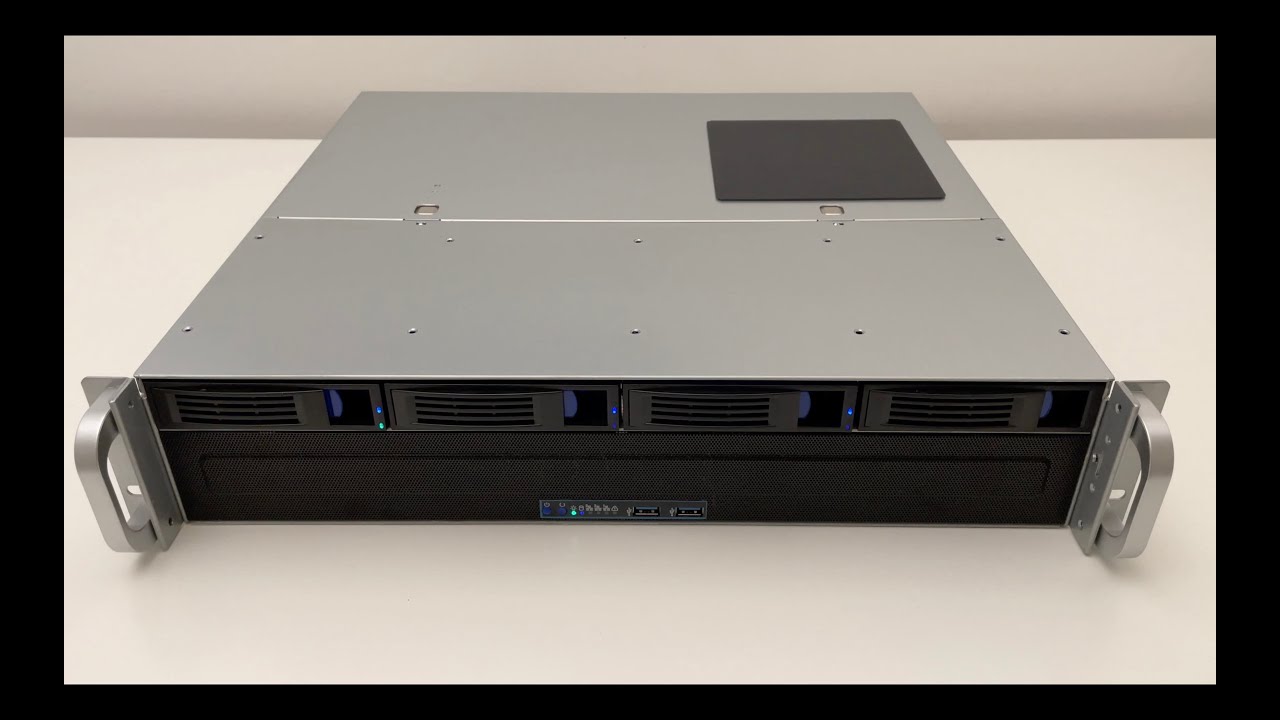
CPU: 12 Core AMD Ryzen 9 5900X 3.7GHz
Motherboard: ASRock B550M Pro4 Micro ATX
RAM: 128GB HyperX 3200Mhz DDR4 (4 x 32GB)
CPU Cooler: Noctua NH-L12S
Storage: 3 TB Samsung 860 EVO SSD (3 x 1TB)
NIC: Intel I350-T4
GPU: GeForce GT 710
Chassi: Inter-Tech IPC 2U-2404S
PSU: Chieftec PSF-400B
140MM Magnetic fan dust filter cover from Amazon
CPU idle temp: ~50C
CPU 100% load temp: 81C .
source
Technology
Apple building a smart home display with iPad running ‘homeOS’, claims report
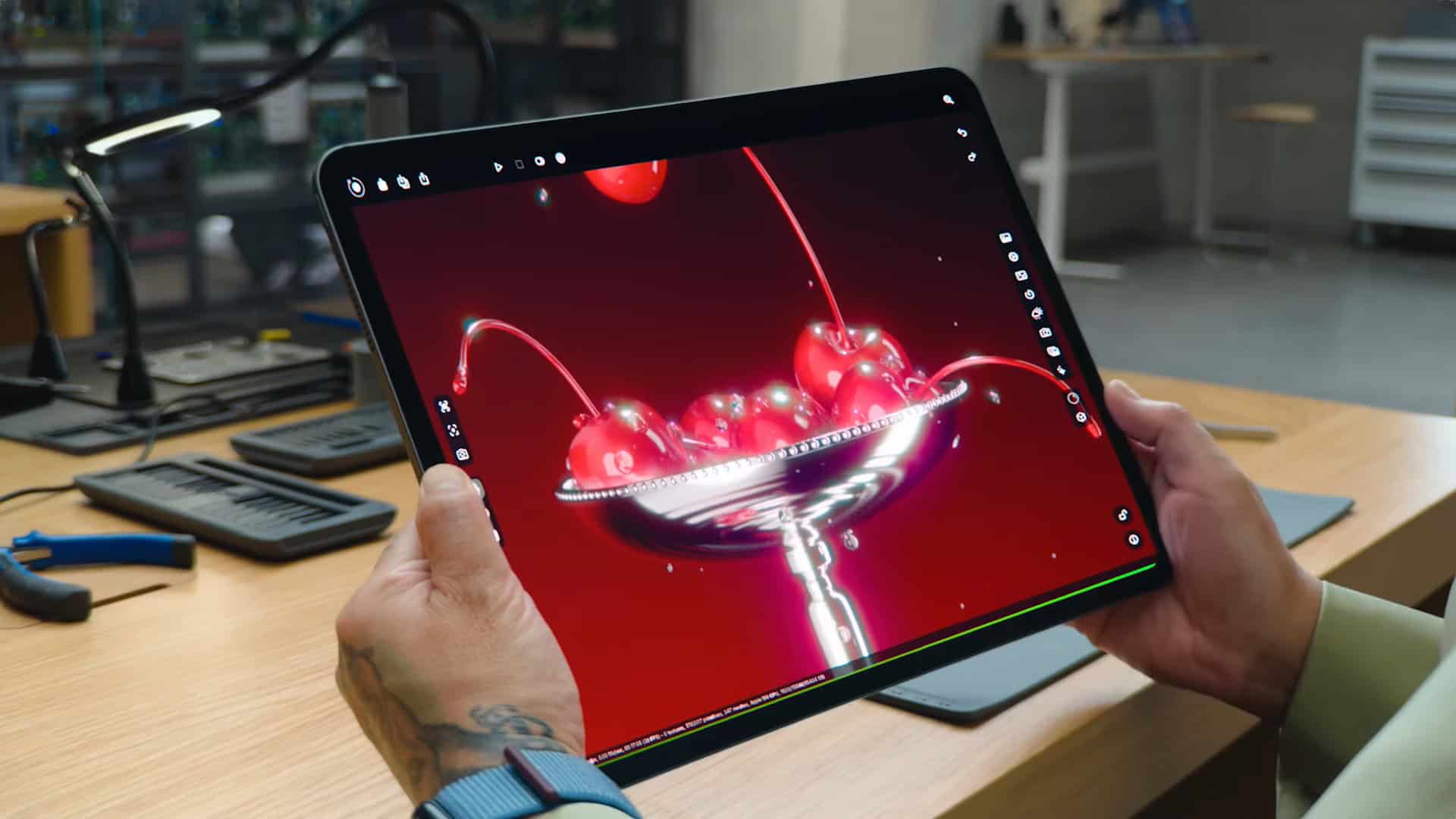
Apple is readying a smart home display with an iPad running a tweaked version of tvOS, claims a new report. The smart home display from the iPhone maker could be marketed under the category “HomeAccessory” and it could support voice and hand gestures.
Apple smart home display would have an iPad running “homeOS”
Apple has been leading the smartphone and tablet market with the iPhone and the iPad respectively. It has a strong presence in the personal computing space with the iMacs and MacBooks.
Apple even has the Apple Vision Pro for the Mixed Reality market. However, Meta surprised the world with an aggressively priced Meta Quest 3S and the Orion Augmented Reality headset with a holographic display.
According to Bloomberg’s Mark Gurman, Apple is now shifting its attention to the smart home market. He claims the as-yet-unannounced smart home display would have a new operating system, called homeOS.
Apple TV’s tvOS currently drives HomePods. This OS could be customized for smart home sensors, IoT, and smart gadgets. It would run core Apple apps like Calendar, Notes, and Home.
The smart home display would have Apple’s Generative Artificial Intelligence, Gurman has indicated. This feature would place this product above Apple’s HomePods.
If Gurman’s predictions are accurate, Apple’s next big product for the smart home market could have an iPad as a display. It seems Apple has already tested a few prototypes, one which had magnets for wall mounting and the other sat on a dock placed on a desk.
Apple working on a ‘HomeAccessory’?
Apple Intelligence has still to catch up with OpenAI’s ChatGPT, X’s Grok, and other popular Gen AI platforms. The iOS developer was a little late to the AI arena, but it is catching up quickly.
Apple would surely want homeOS to work well with Apple Intelligence on the upcoming product. Needless to say, this would involve a lot of coding, testing, and experimentation with software and hardware.
Apple does have an iPad, a HomePod, tvOS, and several other elementary components needed for a smart home display. A recent rumor even suggested Apple is readying to unveil a “HomeAccessory”. This square-shaped device would accept voice and gesture inputs. According to The Verge, Apple could introduce the smart home display with an iPad running homeOS next year.
Technology
California Gov. Newsom vetoes bill SB 1047 that aims to prevent AI disasters

California Gov. Gavin Newsom has vetoed bill SB 1047, which aims to prevent bad actors from using AI to cause “critical harm” to humans. The California state assembly passed the legislation by a margin of 41-9 on August 28, but several organizations including the Chamber of Commerce had urged Newsom to veto the bill. In his veto message on Sept. 29, Newsom said the bill is “well-intentioned” but “does not take into account whether an AI system is deployed in high-risk environments, involves critical decision-making or the use of sensitive data. Instead, the bill applies stringent standards to even the most basic functions – so long as a large system deploys it.”
SB 1047 would have made the developers of AI models liable for adopting safety protocols that would stop catastrophic uses of their technology. That includes preventive measures such as testing and outside risk assessment, as well as an “emergency stop” that would completely shut down the AI model. A first violation would cost a minimum of $10 million and $30 million for subsequent infractions. However, the bill was revised to eliminate the state attorney general’s ability to sue AI companies with negligent practices if a catastrophic event does not occur. Companies would only be subject to injunctive relief and could be sued if their model caused critical harm.
This law would apply to AI models that cost at least $100 million to use and 10^26 FLOPS for training. It also would have covered derivative projects in instances where a third party has invested $10 million or more in developing or modifying the original model. Any company doing business in California would be subject to the rules if it meets the other requirements. Addressing the bill’s focus on large-scale systems, Newsom said, “I do not believe this is the best approach to protecting the public from real threats posed by the technology.” The veto message adds:
By focusing only on the most expensive and large-scale models, SB 1047 establishes a regulatory framework that could give the public a false sense of security about controlling this fast-moving technology. Smaller, specialized models may emerge as equally or even more dangerous than the models targeted by SB 1047 – at the potential expense of curtailing the very innovation that fuels advancement in favor of the public good.
The earlier version of SB 1047 would have created a new department called the Frontier Model Division to oversee and enforce the rules. Instead, the bill was altered ahead of a committee vote to place governance at the hands of a Board of Frontier Models within the Government Operations Agency. The nine members would be appointed by the state’s governor and legislature.
The bill faced a complicated path to the final vote. SB 1047 was authored by California State Sen. Scott Wiener, who told TechCrunch: “We have a history with technology of waiting for harms to happen, and then wringing our hands. Let’s not wait for something bad to happen. Let’s just get out ahead of it.” Notable AI researchers Geoffrey Hinton and Yoshua Bengio backed the legislation, as did the Center for AI Safety, which has been raising the alarm about AI’s risks over the past year.
“Let me be clear – I agree with the author – we cannot afford to wait for a major catastrophe to occur before taking action to protect the public,” Newsom said in the veto message. The statement continues:
California will not abandon its responsibility. Safety protocols must be adopted. Proactive guardrails should be implemented, and severe consequences for bad actors must be clear and enforceable. I do not agree, however, that to keep the public safe, we must settle for a solution that is not informed by an empirical trajectory analysis of AI systems and capabilities. Ultimately, any framework for effectively regulating AI needs to keep pace with the technology itself.
SB 1047 drew heavy-hitting opposition from across the tech space. Researcher Fei-Fei Li critiqued the bill, as did Meta Chief AI Scientist Yann LeCun, for limiting the potential to explore new uses of AI. The trade group repping tech giants such as Amazon, Apple and Google said SB 1047 would limit new developments in the state’s tech sector. Venture capital firm Andreeson Horowitz and several startups also questioned whether the bill placed unnecessary financial burdens on AI innovators. Anthropic and other opponents of the original bill pushed for amendments that were adopted in the version of SB 1047 that passed California’s Appropriations Committee on August 15.
-

 Womens Workouts6 days ago
Womens Workouts6 days ago3 Day Full Body Women’s Dumbbell Only Workout
-

 Technology2 weeks ago
Technology2 weeks agoWould-be reality TV contestants ‘not looking real’
-

 News1 week ago
News1 week agoOur millionaire neighbour blocks us from using public footpath & screams at us in street.. it’s like living in a WARZONE – WordupNews
-

 Science & Environment1 week ago
Science & Environment1 week ago‘Running of the bulls’ festival crowds move like charged particles
-

 Science & Environment1 week ago
Science & Environment1 week agoHyperelastic gel is one of the stretchiest materials known to science
-

 Science & Environment2 weeks ago
Science & Environment2 weeks agoMaxwell’s demon charges quantum batteries inside of a quantum computer
-

 Science & Environment2 weeks ago
Science & Environment2 weeks agoSunlight-trapping device can generate temperatures over 1000°C
-

 Science & Environment2 weeks ago
Science & Environment2 weeks agoHow to unsnarl a tangle of threads, according to physics
-

 Science & Environment2 weeks ago
Science & Environment2 weeks agoHow to wrap your mind around the real multiverse
-

 Science & Environment2 weeks ago
Science & Environment2 weeks agoPhysicists are grappling with their own reproducibility crisis
-

 News2 weeks ago
News2 weeks agoYou’re a Hypocrite, And So Am I
-

 Science & Environment2 weeks ago
Science & Environment2 weeks agoITER: Is the world’s biggest fusion experiment dead after new delay to 2035?
-

 Science & Environment2 weeks ago
Science & Environment2 weeks agoLiquid crystals could improve quantum communication devices
-

 Sport1 week ago
Sport1 week agoJoshua vs Dubois: Chris Eubank Jr says ‘AJ’ could beat Tyson Fury and any other heavyweight in the world
-

 Science & Environment2 weeks ago
Science & Environment2 weeks agoQuantum ‘supersolid’ matter stirred using magnets
-

 Science & Environment2 weeks ago
Science & Environment2 weeks agoWhy this is a golden age for life to thrive across the universe
-

 Science & Environment2 weeks ago
Science & Environment2 weeks agoQuantum forces used to automatically assemble tiny device
-

 Science & Environment2 weeks ago
Science & Environment2 weeks agoNuclear fusion experiment overcomes two key operating hurdles
-

 Science & Environment2 weeks ago
Science & Environment2 weeks agoCaroline Ellison aims to duck prison sentence for role in FTX collapse
-

 Science & Environment2 weeks ago
Science & Environment2 weeks agoLaser helps turn an electron into a coil of mass and charge
-

 Science & Environment2 weeks ago
Science & Environment2 weeks agoNerve fibres in the brain could generate quantum entanglement
-

 CryptoCurrency1 week ago
CryptoCurrency1 week agoCardano founder to meet Argentina president Javier Milei
-

 News1 week ago
News1 week agoIsrael strikes Lebanese targets as Hizbollah chief warns of ‘red lines’ crossed
-

 Science & Environment2 weeks ago
Science & Environment2 weeks agoTime travel sci-fi novel is a rip-roaringly good thought experiment
-

 Womens Workouts1 week ago
Womens Workouts1 week agoBest Exercises if You Want to Build a Great Physique
-

 Science & Environment1 week ago
Science & Environment1 week agoMeet the world's first female male model | 7.30
-

 CryptoCurrency1 week ago
CryptoCurrency1 week agoEthereum is a 'contrarian bet' into 2025, says Bitwise exec
-

 CryptoCurrency1 week ago
CryptoCurrency1 week agoDZ Bank partners with Boerse Stuttgart for crypto trading
-

 Womens Workouts1 week ago
Womens Workouts1 week agoEverything a Beginner Needs to Know About Squatting
-

 News1 week ago
News1 week agoBrian Tyree Henry on voicing young Megatron, his love for villain roles
-

 News2 weeks ago
News2 weeks ago▶️ Media Bias: How They Spin Attack on Hezbollah and Ignore the Reality
-

 Science & Environment2 weeks ago
Science & Environment2 weeks agoQuantum time travel: The experiment to ‘send a particle into the past’
-

 Science & Environment1 week ago
Science & Environment1 week agoWhy we need to invoke philosophy to judge bizarre concepts in science
-

 CryptoCurrency1 week ago
CryptoCurrency1 week agoBitcoin miners steamrolled after electricity thefts, exchange ‘closure’ scam: Asia Express
-

 CryptoCurrency1 week ago
CryptoCurrency1 week agoDorsey’s ‘marketplace of algorithms’ could fix social media… so why hasn’t it?
-

 CryptoCurrency1 week ago
CryptoCurrency1 week agoRedStone integrates first oracle price feeds on TON blockchain
-

 CryptoCurrency1 week ago
CryptoCurrency1 week agoBitcoin bulls target $64K BTC price hurdle as US stocks eye new record
-

 CryptoCurrency1 week ago
CryptoCurrency1 week agoBlockdaemon mulls 2026 IPO: Report
-

 CryptoCurrency1 week ago
CryptoCurrency1 week agoCoinbase’s cbBTC surges to third-largest wrapped BTC token in just one week
-

 News1 week ago
News1 week agoFour dead & 18 injured in horror mass shooting with victims ‘caught in crossfire’ as cops hunt multiple gunmen
-

 Womens Workouts6 days ago
Womens Workouts6 days ago3 Day Full Body Toning Workout for Women
-

 Travel6 days ago
Travel6 days agoDelta signs codeshare agreement with SAS
-

 Politics4 days ago
Politics4 days agoHope, finally? Keir Starmer’s first conference in power – podcast | News
-

 Sport1 week ago
Sport1 week agoUFC Edmonton fight card revealed, including Brandon Moreno vs. Amir Albazi headliner
-

 Science & Environment2 weeks ago
Science & Environment2 weeks agoA new kind of experiment at the Large Hadron Collider could unravel quantum reality
-

 Science & Environment2 weeks ago
Science & Environment2 weeks agoA slight curve helps rocks make the biggest splash
-

 CryptoCurrency1 week ago
CryptoCurrency1 week agoCrypto scammers orchestrate massive hack on X but barely made $8K
-

 Science & Environment1 week ago
Science & Environment1 week agoTiny magnet could help measure gravity on the quantum scale
-

 Science & Environment1 week ago
Science & Environment1 week agoHow do you recycle a nuclear fusion reactor? We’re about to find out
-

 CryptoCurrency1 week ago
CryptoCurrency1 week agoLow users, sex predators kill Korean metaverses, 3AC sues Terra: Asia Express
-

 CryptoCurrency1 week ago
CryptoCurrency1 week agoSEC asks court for four months to produce documents for Coinbase
-

 CryptoCurrency1 week ago
CryptoCurrency1 week ago‘No matter how bad it gets, there’s a lot going on with NFTs’: 24 Hours of Art, NFT Creator
-
Business1 week ago
How Labour donor’s largesse tarnished government’s squeaky clean image
-

 News1 week ago
News1 week agoBrian Tyree Henry on voicing young Megatron, his love for villain roles
-

 Womens Workouts1 week ago
Womens Workouts1 week agoHow Heat Affects Your Body During Exercise
-

 Womens Workouts1 week ago
Womens Workouts1 week agoKeep Your Goals on Track This Season
-

 News1 week ago
News1 week agoChurch same-sex split affecting bishop appointments
-

 Technology1 week ago
Technology1 week agoFivetran targets data security by adding Hybrid Deployment
-

 Technology1 week ago
Technology1 week agoiPhone 15 Pro Max Camera Review: Depth and Reach
-

 Science & Environment1 week ago
Science & Environment1 week agoHow one theory ties together everything we know about the universe
-

 Science & Environment2 weeks ago
Science & Environment2 weeks agoBeing in two places at once could make a quantum battery charge faster
-

 CryptoCurrency1 week ago
CryptoCurrency1 week ago$12.1M fraud suspect with ‘new face’ arrested, crypto scam boiler rooms busted: Asia Express
-

 Science & Environment1 week ago
Science & Environment1 week agoUK spurns European invitation to join ITER nuclear fusion project
-

 Science & Environment1 week ago
Science & Environment1 week agoFuture of fusion: How the UK’s JET reactor paved the way for ITER
-

 CryptoCurrency1 week ago
CryptoCurrency1 week agoDecentraland X account hacked, phishing scam targets MANA airdrop
-

 CryptoCurrency1 week ago
CryptoCurrency1 week agoCertiK Ventures discloses $45M investment plan to boost Web3
-

 CryptoCurrency1 week ago
CryptoCurrency1 week agoBeat crypto airdrop bots, Illuvium’s new features coming, PGA Tour Rise: Web3 Gamer
-

 CryptoCurrency1 week ago
CryptoCurrency1 week agoTelegram bot Banana Gun’s users drained of over $1.9M
-
Business1 week ago
Thames Water seeks extension on debt terms to avoid renationalisation
-
Politics1 week ago
‘Appalling’ rows over Sue Gray must stop, senior ministers say | Sue Gray
-

 News1 week ago
News1 week agoWhy Is Everyone Excited About These Smart Insoles?
-

 Politics2 weeks ago
Politics2 weeks agoTrump says he will meet with Indian Prime Minister Narendra Modi next week
-

 Science & Environment2 weeks ago
Science & Environment2 weeks agoSingle atoms captured morphing into quantum waves in startling image
-

 Technology2 weeks ago
Technology2 weeks agoCan technology fix the ‘broken’ concert ticketing system?
-

 Science & Environment2 weeks ago
Science & Environment2 weeks agoHow Peter Higgs revealed the forces that hold the universe together
-

 Health & fitness2 weeks ago
Health & fitness2 weeks agoThe secret to a six pack – and how to keep your washboard abs in 2022
-

 CryptoCurrency1 week ago
CryptoCurrency1 week ago2 auditors miss $27M Penpie flaw, Pythia’s ‘claim rewards’ bug: Crypto-Sec
-

 CryptoCurrency1 week ago
CryptoCurrency1 week agoJourneys: Robby Yung on Animoca’s Web3 investments, TON and the Mocaverse
-

 CryptoCurrency1 week ago
CryptoCurrency1 week agoLouisiana takes first crypto payment over Bitcoin Lightning
-

 CryptoCurrency1 week ago
CryptoCurrency1 week ago‘Everything feels like it’s going to shit’: Peter McCormack reveals new podcast
-

 CryptoCurrency1 week ago
CryptoCurrency1 week agoSEC sues ‘fake’ crypto exchanges in first action on pig butchering scams
-

 CryptoCurrency1 week ago
CryptoCurrency1 week agoBitcoin price hits $62.6K as Fed 'crisis' move sparks US stocks warning
-

 CryptoCurrency1 week ago
CryptoCurrency1 week agoVonMises bought 60 CryptoPunks in a month before the price spiked: NFT Collector
-

 CryptoCurrency1 week ago
CryptoCurrency1 week ago‘Silly’ to shade Ethereum, the ‘Microsoft of blockchains’ — Bitwise exec
-

 CryptoCurrency1 week ago
CryptoCurrency1 week agoVitalik tells Ethereum L2s ‘Stage 1 or GTFO’ — Who makes the cut?
-

 CryptoCurrency1 week ago
CryptoCurrency1 week agoEthereum falls to new 42-month low vs. Bitcoin — Bottom or more pain ahead?
-

 News1 week ago
News1 week agoBrian Tyree Henry on his love for playing villains ahead of “Transformers One” release
-

 News1 week ago
News1 week agoBangladesh Holds the World Accountable to Secure Climate Justice
-

 Womens Workouts1 week ago
Womens Workouts1 week agoWhich Squat Load Position is Right For You?
-

 Technology2 weeks ago
Technology2 weeks agoIs carbon capture an efficient way to tackle CO2?
-

 Fashion Models1 week ago
Fashion Models1 week agoMixte
-

 Politics1 week ago
Politics1 week agoLabour MP urges UK government to nationalise Grangemouth refinery
-

 Health & fitness2 weeks ago
Health & fitness2 weeks agoThe maps that could hold the secret to curing cancer
-

 Science & Environment1 week ago
Science & Environment1 week agoA tale of two mysteries: ghostly neutrinos and the proton decay puzzle
-

 CryptoCurrency1 week ago
CryptoCurrency1 week agoCZ and Binance face new lawsuit, RFK Jr suspends campaign, and more: Hodler’s Digest Aug. 18 – 24
-

 Money1 week ago
Money1 week agoBritain’s ultra-wealthy exit ahead of proposed non-dom tax changes
-

 Womens Workouts1 week ago
Womens Workouts1 week agoSwimming into Your Fitness Routine
-

 Technology6 days ago
Technology6 days agoRobo-tuna reveals how foldable fins help the speedy fish manoeuvre
-

 Science & Environment1 week ago
Science & Environment1 week agoHow to wrap your head around the most mind-bending theories of reality
-

 CryptoCurrency1 week ago
CryptoCurrency1 week agoHelp! My parents are addicted to Pi Network crypto tapper

You must be logged in to post a comment Login